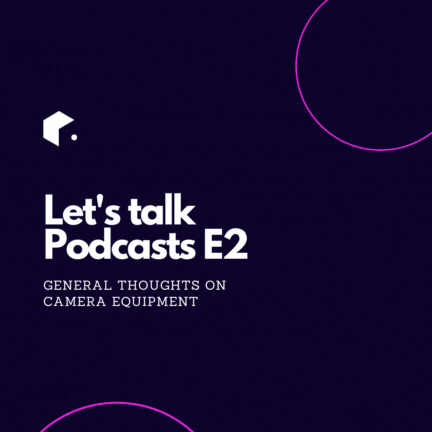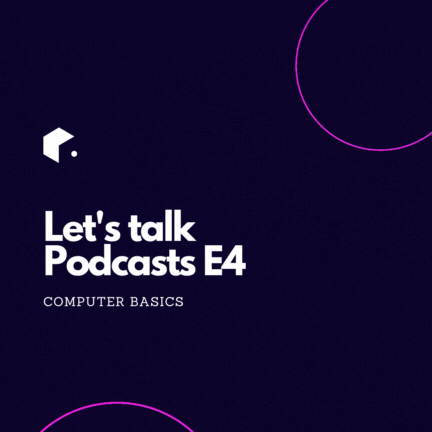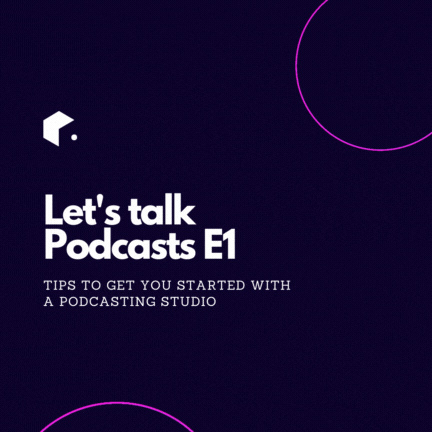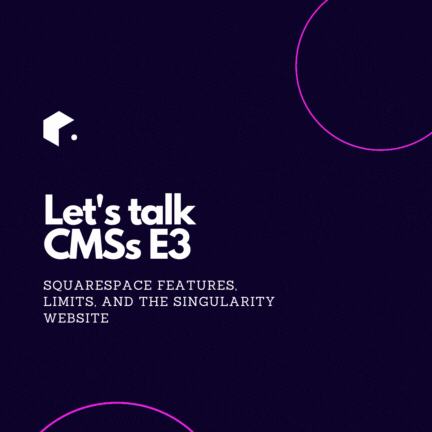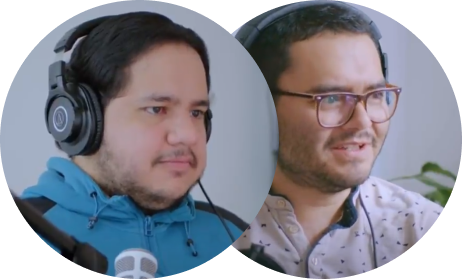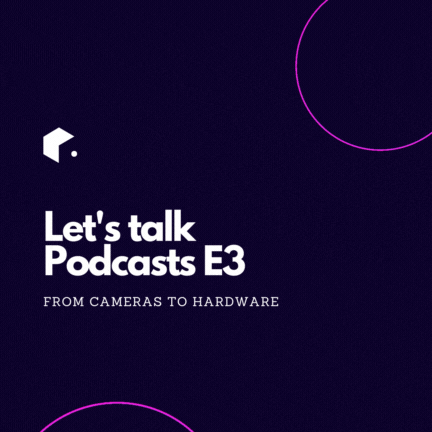
Let's talk Podcasts E3: From cameras to hardware
Episode transcription
Introduction and Recap of Previous Episode
[00:00:00] Diana: Well, hello, welcome back to another episode of our podcast. I'm Diana, your host for today, and this is part three of a series of the discussions regarding how to set up your home studio or your office studio. Joining me today, again, I have Diego. How are you today, Diego?
[00:00:28] Diego: Doing great. Diana, how are you?
[00:00:30] Diana: I'm very good. Thank you very much. So, Diego, basically, you are... I will say that you're an expert in this topic area, okay, or at least you know way more than me in this topic area.
[00:00:45] Diego: Kind of an enthusiast. Yes.
[00:00:47] Diana: So, I learned so much from our last podcast episode and if you missed our last episode, make sure to check it out. We discussed the essential considerations for choosing the perfect camera for your home or your office studio. So, just to quickly, summarize the main points being discussed in our last episode. We talked a little bit about whether to choose a cell phone or a camera when you're starting to create content. Also whether it is a good idea or not to buy a secondhand or a used camera. We also talked about a couple of non-negotiables. I mean, a couple of the must-haves when working with a camera. We talked as well about the importance of having HDMI cables in our camera setup. And also a little bit about microphones and finally we talked as well about the learning curve, like the process of learning how to use your camera setup.
Understanding Different Types of Cameras
[00:02:19] Diana: So, I would like to extend more, a little bit more on the topic of cameras, and I remember that last time we talked, you mentioned the importance of using, for example, mirrorless cameras, and I did some research about these types of cameras and I also came across other types of cameras called DSLR cameras. So, let's begin with that, okay, as our point of discussion, as a beginning of our discussion. So, let's talk about DSLR cameras versus mirrorless cameras. What is your take on both of them?
[00:03:15] Diego: Okay, glad to tell you. So, DSLR cameras are pretty much; are basically an old technology and cameras. And pretty much all the camera brands nowadays produce mirrorless cameras. It'll be very uncommon to buy a new or recently launched camera nowadays that will be DSLR. I believe only Pentax produces that kind of camera technology nowadays, although, don't quote me on that, I'm not really sure about it. But yes, it's, the difference between those is at a technical level there a difference in how the structure, the internal structure of the camera is laid out. So, as the sensor to be able to receive light and mirrorless cameras were pretty much a breakpoint on how that process of getting light into the sensor of the camera was achieved. And ever since all of the brands pretty much all of the brands switched to mirrorless technology. So, in the context of our podcasts, it is really not any sort of determinant factor where it is mirrorless or DSLR because we will be pretty much all the time looking at a mirrorless camera.
Now, the reason why you might have phoned that on Google is you probably typed something like types of cameras. When talking about cameras, in general, I suppose that Google takes for granted that you are talking about type of photography cameras and yes, indeed that is a good way of classifying those, especially because many photographers who are not young enough as for not knowing what DSLR will probably be still remembering the days in which there were the two types of cameras during that transition. At very least that is what I believe.
Now, as for types of cameras into the context of our conversations, I will classify those and, this is my classification for this topic, by the way; I'll classify those into what I'll call hybrid cameras, which are DSLR cameras. Okay. I will... I will get into that pretty much all common cameras that you might have seen, the type of camera that a photography very often uses. But nowadays all those cameras are very well prepared to record very good video. So, I'm calling those hybrid. I will also have survey category for cell phones because that is a tool that is certainly useful for producing content. Not only because if you only have a cell phone you can produce with a cell phone, but also because in certain scenarios only a cell phone can get you there. And I will have a third category for cinema cameras, which are cameras that which main or even only purpose will be to record video. And that is also a possibility for people to have as a matter of fact, we both are using cinema cameras right now to record this, and many YouTubers use cinema cameras as well. So, that is another option.
[00:07:55] Diana: Yes.
[00:07:55] Diego: Those, will be my three types of cameras.
[00:08:00] Diana: Absolutely.
[00:08:00] Diego: in the context of this conversation, instead of dividing those into the solar and mirrorless.
[00:08:06] Diana: Oh, I understand. So I will say that maybe if a person's going to create content, so they should basically pick the one that resonates with their style or what the purpose of their content is. I believe because I do understand that the market has a lot of options, and you can feel overwhelmed with all the different types of cameras that there might be out there.
Exploring Camera Lenses and Their Importance
[00:08:39] Diana: But continuing talking a little bit about cameras, but this time adding something more that I would like to further discuss in this episode, would be accessories. Okay. I mentioned last time that we are currently using a camera called Z cam. Okay. And even though that's the camera that we're using right now, we are not necessarily saying that should be the camera to go, that are as I said before, infinity of camera choices. But that's the one that we're using right now. And, when I was doing some research, I realized that the Z cam, the brand of the lens of my Z cam is not the same as the brand of the camera. Actually, if I remember correctly, it's Lumix?
[00:09:41] Diego: It's a Panasonic Lumix.
[00:09:43] Diana: Panasonic.
[00:09:44] Diego: You're right.
[00:09:45] Diana: Yes. So that's a very important accessory as well, or a very important element to complete your camera setup. So, Diego, what do you think should be like a good lens kit for your camera?
[00:10:10] Diego: Wow. Good question. Okay. So, if we're talking about lenses will be... I'm referring to lenses for the two types, or the two categories of cameras that I... two of the category cameras that I just pointed out, which will be the hybrid cameras and cinema cameras. It doesn't mean that you are not to worry about lenses for cell phones, because you have to think about it on cell phones as well. I'm not necessarily referring to buying a cell phone lens; there exist those, by the way, and we have used them, but in cell phones, you will have from two to three lenses nowadays. All cell phones have around that number of lenses, and you to have care about which one to use.
But back to cameras, which I will base my answer, for this type of setup, we are talking about a setup on which you will record conversations, interviews, maybe webinars, podcast, this kind of format where we have been discussed enough, over the last episode, and which is a setup on which you will likely want to have everything compact. Maybe you are into your home office or your home, even in your room, or in your bedroom, I'mean, or maybe in the living room or maybe you are at the office. So, anyways, you will probably want to keep it compact, and therefore, you need a lens that will not be a telescopic lens, that is, the kind of lens that will allow you to focus on very distant objects.
Though you might not want either to have a lens that will be like an eye fish, and that is the other side of the spectrum. Those are lenses that will allow you to have pretty much everything in front of you into the shot. And maybe you don't want that either because you want the people, the audience, to be able to see you, and not necessarily all of the things that are around you. So, maybe if you're at an office you want to have a setup that might as well be desktop for working, or maybe it is only a desk that is specifically attend the purpose of recording podcasts. So, maybe you don't want that people around on desks that are around the recording setup will be in the frame when recording.
So, you don't want an eye fish either. What you would like to have is a lens that will allow you to have the camera at approximately one meter from you, around that distance will be pretty well, maybe one meter, one and a half meters, I'm sorry, I don't use foot, but you can do the conversion on Google. But yes, you would like to have the camera kind of nearby you, not as far from you. And for that... or that will be, in my opinion, one of the certain elements that will allow you to think about which lens do you require. So, as we're talking about that, you will be thinking in a lens that will be ideally around 45-millimeters. I will explain a little bit more about that later. But you'll be thinking about a 45-millimeters for Full Frame. And also I will explain, I will elaborate more about that in a moment. Just try to remember this number 45 or equivalent to 45-millimeters. And that is a lens, I mean, we both are using equivalents to almost 45-millimeters right now. That is the lens that will allow you to have view and frame, and that will allow you to only have around, I don't know, two meters at most of your background. And my background is approximately at 50 centimeters from my back, I mean, the wall that is on my back is approximately at that distance.
So, what's important though is at the kind of lens will allow you to have you to be in the frame the camera, to be about one meter from you and to have one meter on your back, only showing two meters around you yourself on that background. So, that is kind of ideal; you can close it up a little bit with a higher number of millimeters or make it wider with a lower number of millimeters. But overall, I believe that 45 is pretty good. Also, because of the nature of this kind of setup, you are most likely recording yourself from your torso and upwards, and that is kind of common scenario for portraits, it's a portrait what we are doing in terms of composition startup; comparable. And 45 is also kind of around what a photographer will choose in certain scenarios for portraits. There are no rules here, but yeah, I believe that looking at that number will make sense. Okay. This is going to be a very quick introduction what I mean about millimeters and equivalent to. But I believe that in order to get deeper into this will require further episodes, so I'll try to be as quick as possible. There are... the cameras have sensor sizes. This one, for instance, let's say Panasonic Lumix S5, this one is a full-frame sensor. It's kind of the standard bigger sensor. I say standard because there are bigger than... there are some bigger than this one over here.
[00:17:28] Diana: So, a Full Frame sensor means... what does it mean, very quickly, a Full Frame sensor? It means...
[00:17:35] Diego: Okay, yes. So, let me show you this very quickly. The cameras, I mean, the mirrorless or hybrid cameras, which are this type of cameras; they, inside the lens, which is this variable over here, there is this little squarish thing that is called a sensor that is the part of the camera that receives light, and that converts that light into a digital signal. That is the sensor.
Now, cameras such as this one over here are having the biggest standard sensor. Again, there are cameras, commercial cameras having bigger sensors. But this one is the common one, the one that you might be prominent to buy that has the bigger sensor that is... that one is called Full Frame. Now, there are other cameras such as the one that we are using right now that is in the other side of the spectrum for commercial cameras of this type. No, I'm sorry. It is not the... No, forget about what I said. I was about to say that this kind of camera had the smaller standard sensor, but it is not correct. It is almost there. So, there is Full Frame, then, there is micro 4/3". I'll try to grab one here to show you just a sec...
[00:19:15] Diana: It is always a good idea to know about these little terms in order to understand how lenses work. Exactly. Yes.
[00:19:26] Diego: There is a lot to say here. Okay. Then again, there's the bigger one, which is Full Frame. Then we are having a smaller sensor; remember, sensor is the little square that there is inside here.
[00:19:44] Diana: Got it, good.
[00:19:45] Diego: Here is. So, there's this one over here. This is, sorry, that's right. Just a second. Siri got activated!
[00:20:04] Diana: Yeah. Yeah. I can also see that you have other sorts of cameras in your office studio.
[00:20:12] Diego: Yes. Yes. Like I'm trying to covering... Yeah, no, please go ahead.
[00:20:18] Diana: No, I mean, do you use them as well in your content creation?
[00:20:26] Diego: Absolutely.
[00:20:27] Diana: Great.
[00:20:28] Diego: Yes. Both for podcast kind of productions and also to be able to explore the standards across different types of cameras so that we can help potential clients to set up their recording studios. Okay. So, I was talking about there is Full Frame; there's one over here the larger sensor that you are likely to find on any camera for this scenario. Then there is APS-C sensor.
[00:21:09] Diana: Okay.
[00:21:10] Diego: It's just a bit smaller. Then there is micro 4/3", which is the one that we are using, both of us are using right now. And also there is the 1-inch sensor, 1-inch sensor, which you are very likely to find as well for this kind of setups. For instance, the one of the cameras that I talked about from Sony, on our last episode, is a camera that is having this smaller 1-inch sensor the ZV 1F. This been said, the Full Frame camera is kind of the standard reference for how to measure the millimeters on a lens. Remember, I recommend a to start looking at a lens that will be around 45 millimeters. And this one over here is descender. So, when you read about a lens, you will likely read that this is a x millimeters lens for Full Frame, and it gets a little bit messy starting from there, but as you go from a large sensor to a smaller one, you will have a smaller millimeter lens being equivalent to the one that you will have on a Full Frame.
Let me elaborate on this. For instance, a 33-millimeter lens on this camera over here will be kind of equivalent to a 50-millimeters on a Full Frame. So, if you want to... if the camera you both is having this sensor, the APS-C sensor, then, you will be trying to get something around 30 to 33-millimeters on the lens for your camera.
[00:23:26] Diana: Wow.
[00:23:27] Diego: But if you go for a smaller sensor than that, let's say a micro 4/3" sensor, which is the one that we're using right now to record this podcast; if you're going with a camera like that, a camera sensor like that, then, you will be looking at something like between 22 to 25-millimeters, for instance, the lens that we're using right now, which is a Panasonic Lumix, as you mentioned, that one is a 25-millimeters which is equivalent to a 15-millimeters on a Full Frame. When it is micro 4/3", it's pretty simple because you have to multiply by two, so, 25 gets into 50 on Full Frame. When it is APS-C, it's not as easy, but you kind of... it is kind of in the middle of Full Frame and micro 4/3". So that is why we have pretty much almost the same millimeters when we're talking 50 for Full Frame, 33 for a APS-C and 25 for micro 4/3".
Now, when it comes to one-inch cameras, they don't often, at least to my knowledge, they don't have a lens that you can take out of your camera. Those are compact cameras that already have their lenses. There's no kind of decision on the lens when it comes to purchase it, but you do have to have the lens in mind when it comes to using it just as you will with a phone, because those cameras very often have a variable lens and you will have to think a little bit about where to position that, but it really doesn't come to be a decision factor for purchasing that. So, that is a summary on the complexity of lenses.
[00:25:54] Diana: Oh, I understand.
[00:25:55] Diego: To summarize my answer, the millimeters will be probably discerning factor when it comes to choose one. There are more factors. There is the whether it is manual, or it is... it has autofocus, whether it is a primal lens, or whether it is a zoom lens. And there is, of course, the price. So, I will just get started with millimeters, and there are other factors to consider after that.
[00:26:29] Diana: I would also like to discuss what you just mentioned, the last thing that you mentioned, price range. How much money do I have to spend? Overall, because I know that are different price ranges, and later on in upcoming episodes, we're going to focus exclusively on budget. But what about the regular cost of a lens kit?
[00:26:59] Diego: My, my advice will be to spend as little as you can for a lens that fulfill what your require tolerance of functionality. I'll explain myself.
[00:27:12] Diana: So, it's not necessarily the more expensive the better.
[00:27:17] Diego: Exactly. That is just what I was about to tell you. Like, for this kind of production, we're talking about a podcast, a webinar, I mean, live to the cinematographers and the photographers, the spending $500 more into another lens just for the image quality. They will notice they will do a ton of post-production they will totally notice the difference in quality for the image. Now, what real concern to you, on lenses, for this kind of production, is functionality and usability.
And the factors that will determine how much for a lens will be different. So, for instance, if you have a camera that is having autofocus, usable autofocus, then, you will very likely want to invest in lens the task autofocus. But otherwise, if your camera doesn't have autofocus, which is the case for most cinema cameras, or the camera autofocus is just so bad that you cannot rely on it, which is the case, for instance, with cameras such as, I don't know, one of those is the Z cam, I mean, it's good autofocus, it's usable, but it is not reliable; we both use the manual focus.
[00:28:56] Diana: Yes, it's true.
[00:28:57] Diego: Because it's better also it is not difficult for this type of setup. One cool thing that, because you're recording yourself, you truly absolutely require out focus. Reality, though, is that for this kind of setup, you place the camera there, you focus to the distance at which you will be sitting all the time, and you will pretty much never change that so, it's not a big deal, I think. But anyways, if your camera, if you're not going to... if you're not going to use autofocus, then do not invest on a lens that is have an autofocus. It's not necessary.
What else in terms of autofocus, let me think about it, or in terms of the price for a lens, there is also, there's built quality, of course, but, then again, the lens that we're using for this Panasonic, for this Z cam, which is a Panasonic lens, is really cheap. It's plastic, it's, I don't know, it's around $150 or something like that. And yes, there, there are lenses that are having around the same millimeters. Maybe there are things that are in terms of image quality better, but you will not notice those ever for this kind of production. Like, never ever. So, yeah, I just grabbed the grab a kind of average lens. Do not be fooled by... with that temptation of paying $300 more for a lens that is pretty much having the same functionality, but it delivering different results. One thing, though, which I will... I will not necessarily invest more, but I will consider that as a factor if you're looking for a lens that has autofocus because your camera is having good out focus and you will use it. I will certainly think about buying a lens of the brand of that camera, or I will read a lot about the reviews on older third-party brands in terms of autofocus because, it's generally, Sony lenses go very well with Sony cameras, but it's not a rule like, there are many third-party lenses that have very good integration with older cameras in terms of outer focus.
[00:31:46] Diana: Great. Very good. And one last thing that I would like to discuss regarding cameras before we continue talking about something else.
Understanding Camera Stabilization
[00:31:57] Diana: Is something that makes me wonder, it's about a shaky footage. I have had a lot of experience working with my own room setup, which means that I have been experimenting a lot, regarding what should be the best placement for my film equipment. And I have found myself in situations where I record a video, and later on in the post-production phase, I discover that the video was shaky and, of course, it has been a hundred percent my fault. I have misplaced or, well, not even misplaced, but I have placed my film equipment next to, for example, my table without realizing that it can cause an interference in the filming process. For example, having a shaky footage.
So, again, doing a little bit of research, I have come across different types of cameras. For example, cameras that have built-in stabilization. I have read about certain Sony cameras and certain Canon cameras as well, but I also know that there are other cameras which require external stabilizers. And I know for sure and everybody that tries to create content know for sure that in order to create professional visuals, you need steady shots. So, what about that, Diego? Would you recommend a camera that has a built-in stabilization, or one that requires an external one?
[00:34:13] Diego: Good question. Excellent. That's wonderful, for my answer is neither. The type of setup that we are having for this conversation is for podcast, then again, webinars, that kind of thing. Those are setups on which the camera will be static. I mean, you are not, and there is no one grabbing the camera to move around. The camera is to be on its place, and you are being on your place and there is no movement. So, stabilization, whether it is into the camera, into the lens, or with a gimbal or older devices, that stabilization is something you will think about when creating content that requires you to move the camera.
I don't know. Let's say that you're recording yourself in a selfie mode like that, and you are walking around when you're doing the show, or let's say that you are maybe the camera. You want a steady shot, you are on an event, and you are with your camera in your hand, and you're required to record someone in an interview in a quick interview. I don't know, maybe a 30-seconds interview. You are required to be with the camera in your hand or maybe on a gimbal or maybe, what I mean is you, don't have the, possibility to have a tripod with to record that. So, that is why stabilization exists, among other cases. But for this kind of scenario, you will not really use stabilization, and that won't be that useful either. For instance, this camera over here, the Panasonic Lumix S5, is having one of the best, if not best stabilization on the market for full frame sensors.
[00:36:25] Diana: Okay.
[00:36:26] Diego: This one over here is not having stabilization, but you can get stabilization into the lens that goes attached to this camera. Stabilization is a mixture of motors that are holding the sensor and as the camera detects small movements, the those motors adjust the position of the sensor so that the image goes well. And that can also happen with the lenses that are inside a lens, what I means, inside of this device over here, the variable of the lens, there are like small lenses, pieces of glass, and those pieces of glass can be stabilized as well mechanically. And there are lenses that do that; for instance, if you don't have a camera that has stabilization, you come buy a lens that provides a little bit of stabilization, or, for instance, just out of chance, this is not the purpose of having this device that. I'm having the Z cam on the top of a DJI Gimbal.
A Gimbal is a device that allows you to stabilize footage like a lot. And this is not like cameras... camera stabilization are for micro movements or they will, anyways, allow you to walk around. But gimbals are like absolutely steady in terms of movement. And that is also a device that you will use to stabilize the footage as you move or maybe you want to give the impression of no movement and you're having the camera on Gimbal on your hands, that will allow you to do that.
However, then again, because of scenario is that of having the camera pretty much static all the time, what we require is a tripod. And therefore your camera for your decision making for which camera to buy for this specific scenario, will not be affected by the necessity of stabilization, except if you use the... you will use the camera for other scenarios, of course. But I'm trying to isolate the conversation to this scenario as much as I can, and therefore, what you will require is a tripod. It can either be a tabletop tripod, which is a very small tripod that you can put on your table and maybe on your desk or maybe on a desk nearby you, which is what I'm doing right now, or you can buy a tripod like this one over here, which is a tripod that is posed to be sitting on the floor.
And there are different kinds of tripods. There are some that are kind of... Again, in terms of what we... what concerns us; I'm not talking about whether it is a light tripod for traveling, because this is not a scenario that we're considering. But there are tripods that are having that consume a lot of real estate space on your room, and there are others that are minimal; you will probably want to have a minimal one or a tabletop one since this kind of scenario is probably one that will develop into your home or into your office, and you might want to be very conscious about how you use space.
[00:40:37] Diana: Absolutely. And now that you're talking about tripods, by the way, the one that I'm using right now is the one that you showed, is the one that it's been fixed on the floor. Not fixed necessarily, but it's the one that comes from the floor and you just adjusted to your space. But let's talk about that.
Discussing Setup Accessories and Room Setup
[00:41:05] Diana: Let's talk about setup accessories because we have already discussed about tripods and cameras. A little bit about microphones, a little bit about the types of cables that we need to have. I want... I would like to expand on the space the film, the recording space that I will have either in my house or in an office. What else do I need? in order to have a great set, basically a great set.
[00:41:43] Diego: Sure. So let's talk about hardware cause people often a lot of consideration on the camera. There are other aspects that are, really as important. So one of those is the tripod, of course. already mentioned that. It doesn't have to be a tripod. I would rather call that the, whatever you're going to use to place the camera into.
[00:42:11] Diana: Yeah.
[00:42:11] Diego: So, it might be a tripod, my one is of those, is a very cheap tripod and this is pretty much not for hauling. I believe any camera that you should consider for this type scenario, I mean, it's a light tripod, but you will not use an Arri Alexa for recording a podcast. And when it comes to small, very compact cinema cameras and cheaps cinema cameras such as the Z Cam or maybe the Blackmagic Cinema Pocket 4K, yeah, a cheap tripod will do you just great. There are other more robust tripods, but yeah, again, it's not really necessary for you to invest a ton of money into a tripod. I am not saying that you should go cheap necessarily because you want to buy something that will last you and more robust tripods will certainly do so. But for, instance, don't invest for this kind of scenario into buying a tripod that is made of carbon fiber as if you will be taking it on a plane to travel somewhere in the mountains. When I'm talking about is that you won't have to be worried about its weight, because you're having extra weight in your plane travel, and you won't also have to be considering its weight because you're carrying a lot of stuff into your back when climbing a mounding or something like that, because it's a tripod that will be pretty much stick into the position you let it for the first time office or home studio, and you will pretty much never move that around. And if you do so, it's not a matter if you're having one extra kilogram of weight...
[00:44:25] Diana: Yeah.
[00:44:26] Diego: ...or whatever number of pounds that might be. So, yes, the tripod is one type of element you can use to place your camera on, but also, there are, as I mentioned before, top table tripods; those are very small and cute, and they will not take you any sort of real estate on your place, which is important, again, maybe this is a setup on your office and you don't want to take one square meter into having a tripod, or maybe that is your home and you just want to keep it compact.
But if you use a tabletop tripod, you have to make sure that either, you are having the most robust possible tabletop because otherwise, you will be moving the camera as you type on your computer, or maybe you are having that tripod and for your camera into another table next to you. That's important because the scenario in which the things are moving... I mean, those are micro-movements; you didn't realize when... but when you write or when you type on your computer, the table is moving. Again, except if you're having a stone table, that is going to affect you. And therefore, you might want to reconsider having a tabletop tripod. And there are also other solutions; those are arms that you can have into your table. It's something very similar to the arm that you're using for your microphone right now. However, those are for cameras, light cameras, by the way, ideally for cameras such as the one 1-inch sensor cameras maybe something like this just way too heavy for that kind of basis. I mean, there're robust basis as well.
But anyways, that is also an option. It's very compact. You can have one of those little sort of arms or things all on your tabletop and that will be keeping things very compact or, oh, it's very similar to the light that you're having right now; it's much the same solution. But imagine a camera instead of a light at the top. However, then again, you will have to make sure that your table is solid as a rock. Otherwise, you will likely face challenges to have your footage steady.
[00:47:23] Diana: Exactly.
[00:47:24] Diego: So, yes, those are the options that I will consider in terms of where to place your camera. Now, moving forward with hardware. There are also cables that you are to consider seems basic, but when you're haven't, you might not be able to produce it, also they are important. So, there's, of course, the USBC cable or USB, depending on what your computer uses. But because we are talking about podcasts, webinars, etc., we're talking about a scenario on which you require your camera to be attached to your computer, your computer to detect that camera as a webcam. You're not only recording on your camera; you're communicating with other people. And although it is possible not to have that workflow because it is possible to record your camera, isolate it from the computer, and just have a video call and pretend that the other people is seeing you through the camera, and that is totally possible; you might want to do the other way around and just have your camera attached to your computer, in which case, you will need a cable going from your computer to a converter, and that converter is going to turn out the signal from the camera into something that your computer can detect as a webcam.
By the way, there are cameras that have a combination of hardware in the camera and software in the computer that can allow you to have the camera detected as a webcam without using a adapter. But I want not ever recommend to do that to go that way because it is cumbersome; you have to be installing things into your computer, it can fail; for instance, for this one over here, I never ever got it right for making it work without the adapter. So, it's better just attach something physical, and it will work all the time. It's just better. You don't have the luxury on this kind of situations to lose time or to lose shots because you wanted to save, I don't know, $40; it's not something you want to do. Okay, what else do we have here in terms of hardware?
So, yes, I talked about cables, adapters, where to place your camera on and this is another one that it's important where to place your microphone on. So, depending on which microphone you buy, you will have a base for the microphone already. There's something like the Blue Yeti that comes, that are very compact, very plug and play that you can just place on the top of your table. What I mean is the, microphone is also a base. It doesn't require another accessory to be used. But there are others like this one over here, or like the one that you're having, both are the same, those are Rode podcaster microphones that requires to have something to hold them near to your mouth, and that's something you have to buy it. So, there's this thing over here; this device holds a microphone with some elastic cables, alright? And what it does is to avoid the microphone to be very affected by the micro-vibrations that the microphone holder can have. Those are micro-vibrations that you won't perceive, but the audio is going to perceive them to grab them, this is why there's this thing over here, and also, there is a base. Ideally, you will be using an arm like that one that you're having that attach attaches to your tabletop mostly with a clap, but you can also just make a hole in your table to keep it there very steady. And that arm can allow you or that arm connects with this device over here so that you can move around your microphone like take it away from your work space...
[00:52:42] Diana: Adjust.
[00:52:43] Diego: ...when you require so.
[00:52:44] Diana: Exactly.
[00:52:45] Diego: Exactly. And to get it nearby you, I truly recommend that kind of solution as well because you won't have anything in your table. So, there's more real estate on your desk or, yes, it's cleaner; also it is adjustable, so depending on your desk, you will be able to have it closer to you, or what I mean is you will... you won't require to approach to the microphone; to you can approach the microphone to you, so it's very convenient. So, yes, those are things that I will consider absolutely important. Of course, you will want to have a computer. Otherwise you won't be able to connect to a webinar or video call or whatever these in which you're using that. And you want to have also headphones, those are very important. So, headphones are important for two reasons. One of those is you are required to monitor yourself, especially when you're first setting up your environment. You want to hear how you will sound. You can't use your computer's audio to do that because you can't really trust your computer. No matter if it is a computer, I don't know, MacBook Pro 16 inches, that is having great audio; you really shouldn't trust your computer to monitor yourself so you can just buy a pair of headphones. It doesn't have to be special, it doesn't have to be expensive. I will just recommend you to use any headphones that you have if you already had them. Now, very often, there's the recommendation of using professional headphones that are having a neutral signature of sound because commercial headphones or headphones that are meant to be used for enjoying music are often having kind of more, a little bit more of bass or high mixer or anything like that. But reality is that for this kind of productions, you're not getting to that level of, you're not an audio engineer, so you will probably not notice; I believe that if you're having AirPods Max or anything like that, sorry, AirPods, AirPods alone, not max.
If you're having a pair of AirPods or Sony ear booths or whatever; those will be sufficient for you to kind of be able to hear if your voice isn't discerning, which is very important when you first set up your environment. And also, of course, you will have to use them for your calls because it is not ideal to have the voices from the people you're talking to on a podcast, for instance, to be caught by the microphone that you're using that will produce echo. And if well there exists a solution to that via software, it's just not ideal. You better use headphones, and also, you be able to hear your counterpart better.
So, seems like a very basic thing, but that adds to that will probably add to the money that you'll have to invest on your setup. And that is why at beginning, I mentioned, at beginning of this series of podcasts, I mentioned that the camera shouldn't catch all of your attention. There are other things in which you're required to invest. Then, there's also scenario that will largely depend on what you want to record, how you want to record it. There are many things that you can do there in that regard. But, for instance, something as basic as having maybe lamps, maybe a little yes, I don't know, some something green. That's always something that's good for your recording, or maybe you want isolate your environment...
[00:57:24] Diana: You mean the plans your background you mean?
[00:57:28] Diego: Exactly, yes.
[00:57:29] Diana: Good. Okay.
[00:57:31] Diego: That is entirely depending on what you want to produce your...
[00:57:36] Diana: Absolutely.
[00:57:36] Diego: ...personal taste. I'm not saying you have to buy those things; maybe your office or home is having already everything that you require, or you want to show in the background. Maybe you wanted to show a pure white simple background as well. So it, it largely depends on what you want to produce and how produce it, but it's something you should consider because maybe you have something in mind and you never allocated some budget to that and when time comes to for you to produce you realize ⸺hey, this is not the background that I wanted!⸺.
[00:58:14] Diana: Yeah.
[00:58:15] Track 1: And I don't have anything around me to do the background that I wanted. So, I will have to go and spend a little bit more on that or, for instance, maybe you are you're wanting to have a sort of background, how may you call that? Something like this solution that you implemented, sort of a rolling?
[00:58:41] Diana: Blinds.
[00:58:43] Diego: Blinds. You might want to invest in something like that.
[00:58:47] Diana: Yeah.
[00:58:48] Diego: You might want to invest in different blinds so that you can change the color, maybe one white for one series of productions, but maybe you want to change it to, I don't know, green or black or gray for another kind of production. So, yes, that is something, I mean, it can be free, or you can invest on it. It will all depend on every scenario. But what's important though is that you consider it as part of the costs in terms of time and probably as well in terms of money.
[00:59:32] Diana: Yes,
[00:59:33] Diego: So, yes, there you are.
[00:59:35] Diana: You also have to consider the space where you're going to work. Of course, we're talking about two very specific examples, which is my situation and Diego's situation. I want to talk about room setup because you already mentioned considering all the elements that you will have to place in a specific space. Right now, I am in a very small room, and people who are watching this podcast, not those who are listening to us, but those who are watching us, wouldn't even think of the space where I am in right now. because it's very limited. What you can see, it's very limited. You can also see a plain white background, but around me, there's also a very limited space. So, you have to be very mindful, in regards, all the elements that you're going to have around you. You have to be very aware of your surroundings and how you're going to move and how you're going to create your content. My space is very limited, but even so, I have managed to work around that. I have managed to place my drive bot, my camera, my computer, my microphone, my blinds, even my table and my chair in a specific position and with that specific position that I always set up, every time that I'm going to record, I'm doing good. I don't have to worry about the rest of the space that I have in my room or if I am disturbing anybody because I know exactly what I'm going to produce in that moment. Do you think that we need a big space in order to deliver, I'm sorry, good quality content?
[01:01:47] Diego: Not at all, not at all. Both followers are good examples; I mean, in the office, we have plenty room to for our setups, but I am currently recording also on my home studio because I'm sharing my studio with my wife; there is her desk in front of me and there are other things around, and yeah, it's not like I'm having ton of space as we do have in the office. We do have that luxury in the office, but I believe that for most people, this scenario will be something they could probably find themselves into, and it is absolutely possible to produce high-quality content and to get a absolutely winner set up with a small space. And many YouTubers, many content producers, and many people like you and I producing content have their setups very carefully planned and very smartly, developed with the time-space.
[01:03:14] Diana: Yeah. So, what I'm trying to say is that don't feel discouraged if you have a small space. You can always work around it, and it doesn't really, it's not going to really affect the quality of your videos not at all.
Conclusion and Preview of Upcoming Topics
[01:03:31] Diana: So, of course, there's so much to say about video production. I still want to talk about, for example, post-production; I would like to talk about, I will like to continue talking about lighting; I will also like to continue to talk about microphones, as well. So, there is still plenty to discuss, and we're going to do that in our upcoming podcast episodes.
So, I believe that this is a perfect time to wrap to today's episode. Diego, I can only thank you every time we have these sort of discussions because I know that whoever is watching us is learning, but I'm also learning along with them. So, I want to thank you, I want to thank the way... I want to be grateful with the way that you explain so many things that for some people can be something very abstract or very difficult to understand. Your explanations and your insights are very helpful, especially for those who are just starting or those who feel doubtful regarding what sort of equipment to buy, or what sort of software of apps to use. So, thank you so much for your insights.
[01:05:08] Diego: Oh, many thanks for your kind words. Acknowledging that this is helpful to you and maybe other people really does really inspires me to move ahead with this kind of stuff.
[01:05:22] Diana: Absolutely.
[01:05:22] Diego: Thank you. Thank you.
[01:05:24] Diana: Thank you. So well, thank you for tuning in today's episode. There's something that I didn't mention before, but please don't forget to hit the subscribe button and stay tuned for our upcoming podcast episodes. Okay? I'll see you next time, so bye-bye everybody.
[01:05:47] Diego: Bye-bye Diana. See you.
[01:05:49] Diana: See you.
About the series
Join us for Tech Talk, a business podcast hosted by the Quo Agency, a leading provider of complex CMS integrations and website design and development services. Our expert guests and hosts dive into the latest technology trends, and industry news and share insights and strategies to help businesses succeed in the digital space. So whether you're a seasoned tech pro or just starting, Tech Talk is the podcast for you. Please tune in and find out about the latest in website development, CMS integrations, and more.
Key moments



